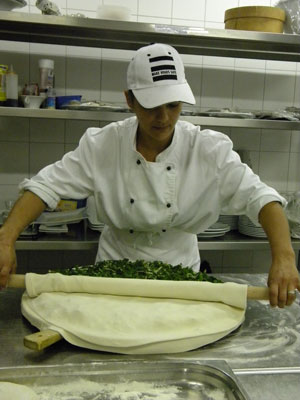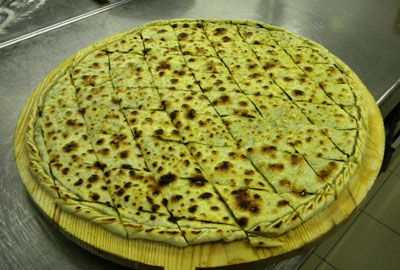What's Cooking in... Split, Croatia
This item appears on page 57 of the October 2012 issue.
When John and I were in Split, Croatia, a couple years ago, we stayed at Le Méridien Lav (Grljevacka 2A, Podstrana, Split 21312, Croatia; phone [385] [21] 500500), where we paid $105 a night and had planned to take a cooking class.
Since we were visiting in low season (October), however, no classes were being offered, but Chef Tomislav arranged to have one of his helpers, Snjezana Matijas, show us how to make a local favorite, soparnik. Soparnik resembles a two-crust pizza filled with Swiss chard.
Chef Tomislav explained that Split, Croatia, is where pizza originated.
It seems that when the Roman Emperor Diocletian became ill, in AD 305, he abdicated and retired to Split. With Diocletian came many Romans who enjoyed the local soparnik and took the recipe back to Rome, where, over the years, it evolved into pizza as we know it today.
(Built in Split in the fourth century, Diocletian’s Palace, many parts of which are still in use, is one of the best-preserved Roman sites. This UNESCO World Heritage Site is the living, pulsating heart of the city.)
At Le Méridien Lav, scheduled cooking experiences are no longer offered, but guests who are interested can contact the hotel to arrange a private class. The cost will be based on the length of the class and the recipes chosen. As an example, for a one-hour class to make a one-dish item like soparnik, the price for one person would be $50.
For filling:
1 lb Swiss chard (can substitute other greens)
¼ small head of cabbage
3 tbsp olive oil
Dash of sea salt
Dash of sugar
For dough:
12 oz cold water
1 tsp salt
4 tbsp olive oil
1 lb all-purpose flour
4 tbsp minced garlic
2 tbsp olive oil
Discard stems from Swiss chard, and julienne the leaves. Refrigerate it overnight to eliminate any moisture from washing; it must be really dry for the pie. The next day, mix Swiss chard, cabbage, oil, sea salt and sugar in a bowl. Set aside.
To make the dough, add water, salt and olive oil to the flour and knead until well mixed. Let it sit for 45 minutes. Split the dough in half. Lightly flour a rolling pin and dough. Roll the dough out to about 16 inches in diameter and place on an ungreased pizza pan or baking sheet sprinkled with cornmeal. Cover the dough with the Swiss chard mixture. Roll the second half of the dough to the same size and place over the Swiss chard, pinching the edges of the top and bottom crusts together. Bake at 425°F for 20 minutes or until the crust is light brown.
Combine the remaining oil and the garlic and brush the top of the pie with the mixture. Cut the pie into diamond shapes and serve. This makes a great appetizer or vegetarian dish.


